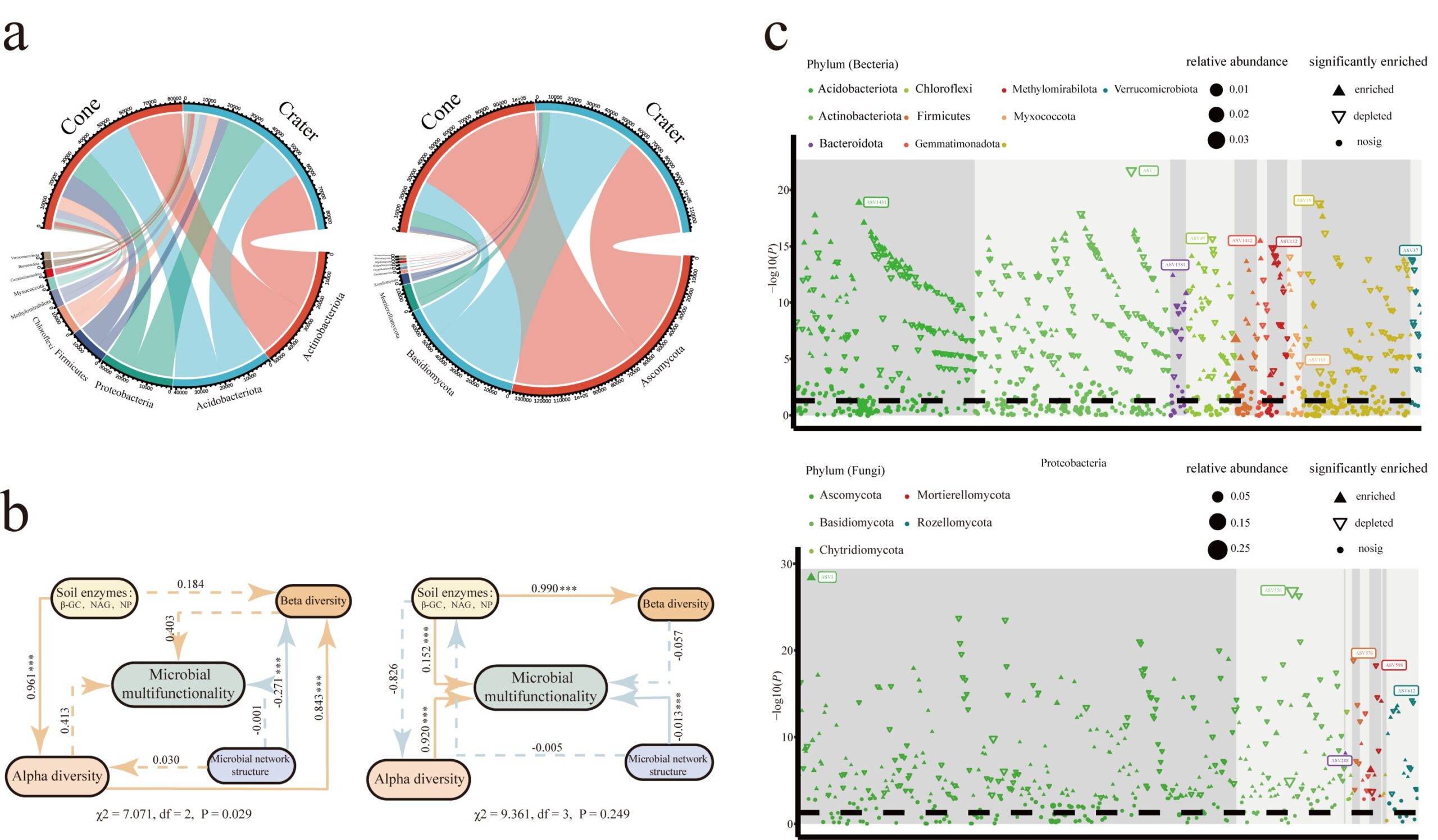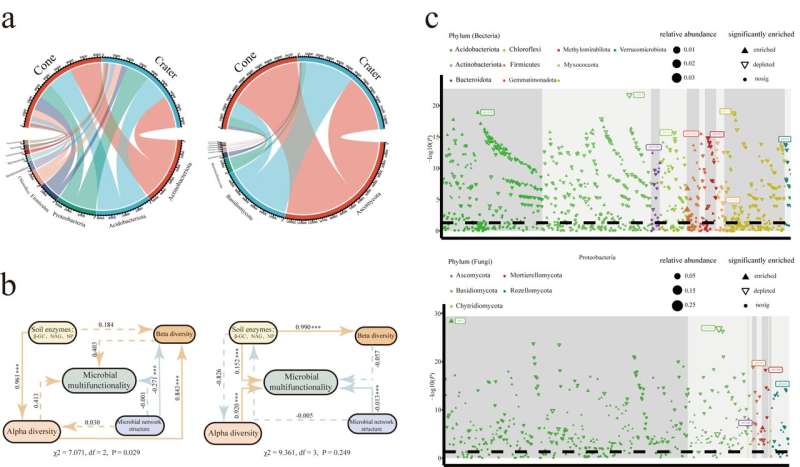

Volcanic activity alters the Earth’s surface and promotes the development of new ecosystems, providing valuable models for studying soil formation processes such as microbial composition and vegetation succession. Increasing evidence suggests that soil microbes are pivotal in numerous ecological and biogeochemical processes, encompassing carbon mineralization, humus formation, and nutrient cycling.
Given the intricate and dynamic interactions between soil properties, plant life, and soil microbial communities, a comprehensive understanding of soil microbial communities is critical to improving our understanding of ecosystem processes. The study shows that the rhizosphere microbial communities of volcanic Boehmeria nivea L. in Nvshan, Anhui Province shows significant spatial differences in diversity, structure, and function.
Volcanic soil plays a key role in the formation of microbial community diversity and subsequently influences the diversity of microorganisms residing in the rhizosphere of ramie. The researchers’ finding appeared July 26, 2024 in Soil Ecology Letters.
Li Xiaoyu’s team at Anhui Agricultural University conducted a series of studies on different sites of rhizosphere microbial communities in volcanic B. nivea, and obtained many interesting findings. For example, their findings suggest that fungal communities show greater vulnerability to changes in geography and environment. In addition, there were differences in the structural and functional diversity of the rhizosphere microbial communities in volcanic pits and volcanic cones, suggesting that the rhizosphere microbial communities were mainly affected by volcanic sites.
Professor Chen said, “We chose to study the Nvshan region in Anhui Province, a dormant volcano recognized globally as one of the best preserved ancient craters, located in the subtropical monsoon climate zone, with an average annual precipitation of 939.9 mm and an average annual temperature of 15 °C. The Nvshan volcanic area has obvious geomorphic features, including craters, lava platforms, lava flows and volcanic cones.
“The volcano has experienced many eruptions during its geological evolution, forming its unique landform landscape. Therefore, Nvshan Volcano provides a suitable, high-quality platform for the study of volcanic activity and environmental disturbances, and B. nivea, as a plant of important economic and ecological value, plays a key role in its rhizosphere microbial community.”
In this study, they found that it was easier to support bacteria rather than fungi at various sites in the rhizosphere soil of B. nivea, a phenomenon that could be attributed to increased disturbance intensity, which could lead to the disappearance of rare fungal species and thus a decline in biodiversity. The Zi-Pi chart illustrates the critical role of key species.
One step supports this observation, showing that the proportion of bacterial generalist species is higher than that of fungi in both the crater (15.5% vs. 11.7%) and the cone (19.2% vs. 13.9%). Actinomycetes and Acidobacteria dominate the bacterial community, while ascomycetes and basidiomycetes dominate the fungal community.
Actinomycetes play a crucial role in the breakdown of humus because they have multiple enzyme-mediated degradation capabilities and are able to thrive under nutritionally restricted conditions. In contrast, fungi show a greater ability to break down complex organic polymers, such as polyphenols, hemicellulose, and refractory cellulose, compared to bacteria.
Professor Chen added, “We also used RMT random matrix theory to establish bacterial and fungal co-occurrence networks to study cooccurrence patterns of microbial communities in volcanic pits and cones.”
Compared to bacterial networks, fungal networks have a more complex microbial community structure with greater modularity, with tightly connected nodes. Compared with crater, cone has lower avgCC value and higher avgK value in their respective bacterial networks. However, in its respective fungal networks, the cone had lower avgK and avgCC values, suggesting that it reduced the complexity of microbial symbiosis.
In addition, based on the SEM results, we found that the influence of microbial α diversity on microbial versatility was more obvious than that of microbial β diversity. The α diversity of microorganisms in craters has a direct and positive impact on their respective multifunctional capabilities.
“By investigating the impact of volcanoes on the rhizosphere microbial community of ramie, the mechanism of volcanic activity on the soil ecosystem can be deeply understood, and a scientific basis can be provided for the protection of the ecological environment around volcanoes and rational use of land resources. In addition, the research on the rhizosphere microbial community of ramie is helpful to explore the mechanism of microbial action in plant growth and soil ecosystem, and provides theoretical support and technical guidance for agricultural production and soil health management,” said the researcher.
More information:
Jin Chen et al, Characterization of microbial structure and function in the rhizosphere of Boehmeria nivea L.: A comparative study of volcanic cone and crater, Soil Ecology Letters (2024). DOI: 10.1007/s42832-024-0259-x
Provided by
Higher Education Press
Citation:
Study shows microbial diversity differences in volcanic cones and craters (2024, September 13)
retrieved 13 September 2024
from https://phys.org/news/2024-09-microbial-diversity-differences-volcanic-cones.html
This document is subject to copyright. Apart from any fair dealing for the purpose of private study or research, no
part may be reproduced without the written permission. The content is provided for information purposes only.